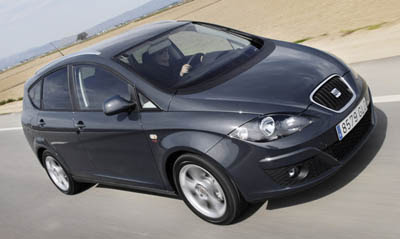Seat Altea Freetrack


The complete launch offer of the SEAT Altea and SEAT Altea XL 2009 range includes 35 different versions divided into two body styles, nine engine choices - five petrol and four Diesel, four gearboxes (5 and 6-speed manual, and 6 and 7-speed DSG), and three trim levels - Reference, Style and Sport. The offer is complete with a new entry-level version and the SEAT Altea Freetrack model, which is available with either two or four-wheel drive and the Sport trim level.
The new SEAT Altea 2009 range is available with a broad equipment list as standard. The entry-level version features the 85 hp 1.4 and 90 hp 1.9 TDI engines on the SEAT Altea and only the 90 hp 1.9 TDI on the SEAT Altea XL, with elements such as ABS and TCS, ESP with EBA, driver and passenger airbag, side airbags, head airbag, rear Isofix anchoring points, front power one-touch anti-trap windows, remote controlled central locking, tinted glass, 15 inch steel rims, 195/65 tyres, double headlights, anti-theft roof aerial, sliding rear seats, storage compartments on the sides of the front and rear seats, central console storage compartment, storage hooks on the boot sides and rear parcel shelf with storage compartments, among others.
As with the SEAT León, the SEAT Altea range continues with the Reference version, which builds on the entry-level version with trip computer, CD radio + MP3 + 6 speakers + Aux in, low tyre pressure warning, air conditioning, body colour door mirrors and handles, front active headrests (on the SEAT Altea XL) and rear door folding shades (also on the SEAT Altea XL).

Style builds on Reference with several more elements, such as cornering foglights, three-spoke leather multi-function steering wheel, leather gearknob, rear power windows, electric heated folding door mirrors, cruise control, Coming Home, chrome inside door handles, climate control, combined USB + Aux in connection, height adjustable driver and passenger seat with lumbar control, 16" 'Enea' alloy rims, 205/55 tyres and visible twin tailpipe on versions with 140 hp or higher engines.
The top of the new SEAT Altea 2009 range is finished in Sport trim, which builds on Style with dark glass, sport seats with specific upholstery, 17" 'Aroa' alloy rims, 225/45 tyres and sports suspension.

Complete list of optional elements
The new SEAT Altea 2009 range features a long list of optional elements that significantly increase onboard comfort and safety.
The Lifestyle Plus package is available on the Reference trim level, which includes cornering foglights, 16 inch alloy rims, multi-function steering wheel and heated door mirrors.
As on the León, the Technology and Technology Plus packages are available on the Style and Sport versions. The Technology package includes rain sensing wipers, rear parking sensor, anti-dazzle rear-view mirror and two extra speakers; while the Technology Plus package includes dual xenon headlights + AFS, the SEAT Mediasystem navigation system, Bluetooth and front parking sensors with parking optics. This package is exclusively associated to the Technology package.
The new SEAT Altea 2009 range is available with a broad equipment list as standard. The entry-level version features the 85 hp 1.4 and 90 hp 1.9 TDI engines on the SEAT Altea and only the 90 hp 1.9 TDI on the SEAT Altea XL, with elements such as ABS and TCS, ESP with EBA, driver and passenger airbag, side airbags, head airbag, rear Isofix anchoring points, front power one-touch anti-trap windows, remote controlled central locking, tinted glass, 15 inch steel rims, 195/65 tyres, double headlights, anti-theft roof aerial, sliding rear seats, storage compartments on the sides of the front and rear seats, central console storage compartment, storage hooks on the boot sides and rear parcel shelf with storage compartments, among others.
As with the SEAT León, the SEAT Altea range continues with the Reference version, which builds on the entry-level version with trip computer, CD radio + MP3 + 6 speakers + Aux in, low tyre pressure warning, air conditioning, body colour door mirrors and handles, front active headrests (on the SEAT Altea XL) and rear door folding shades (also on the SEAT Altea XL).

Style builds on Reference with several more elements, such as cornering foglights, three-spoke leather multi-function steering wheel, leather gearknob, rear power windows, electric heated folding door mirrors, cruise control, Coming Home, chrome inside door handles, climate control, combined USB + Aux in connection, height adjustable driver and passenger seat with lumbar control, 16" 'Enea' alloy rims, 205/55 tyres and visible twin tailpipe on versions with 140 hp or higher engines.
The top of the new SEAT Altea 2009 range is finished in Sport trim, which builds on Style with dark glass, sport seats with specific upholstery, 17" 'Aroa' alloy rims, 225/45 tyres and sports suspension.

Complete list of optional elements
The new SEAT Altea 2009 range features a long list of optional elements that significantly increase onboard comfort and safety.
The Lifestyle Plus package is available on the Reference trim level, which includes cornering foglights, 16 inch alloy rims, multi-function steering wheel and heated door mirrors.
As on the León, the Technology and Technology Plus packages are available on the Style and Sport versions. The Technology package includes rain sensing wipers, rear parking sensor, anti-dazzle rear-view mirror and two extra speakers; while the Technology Plus package includes dual xenon headlights + AFS, the SEAT Mediasystem navigation system, Bluetooth and front parking sensors with parking optics. This package is exclusively associated to the Technology package.













































